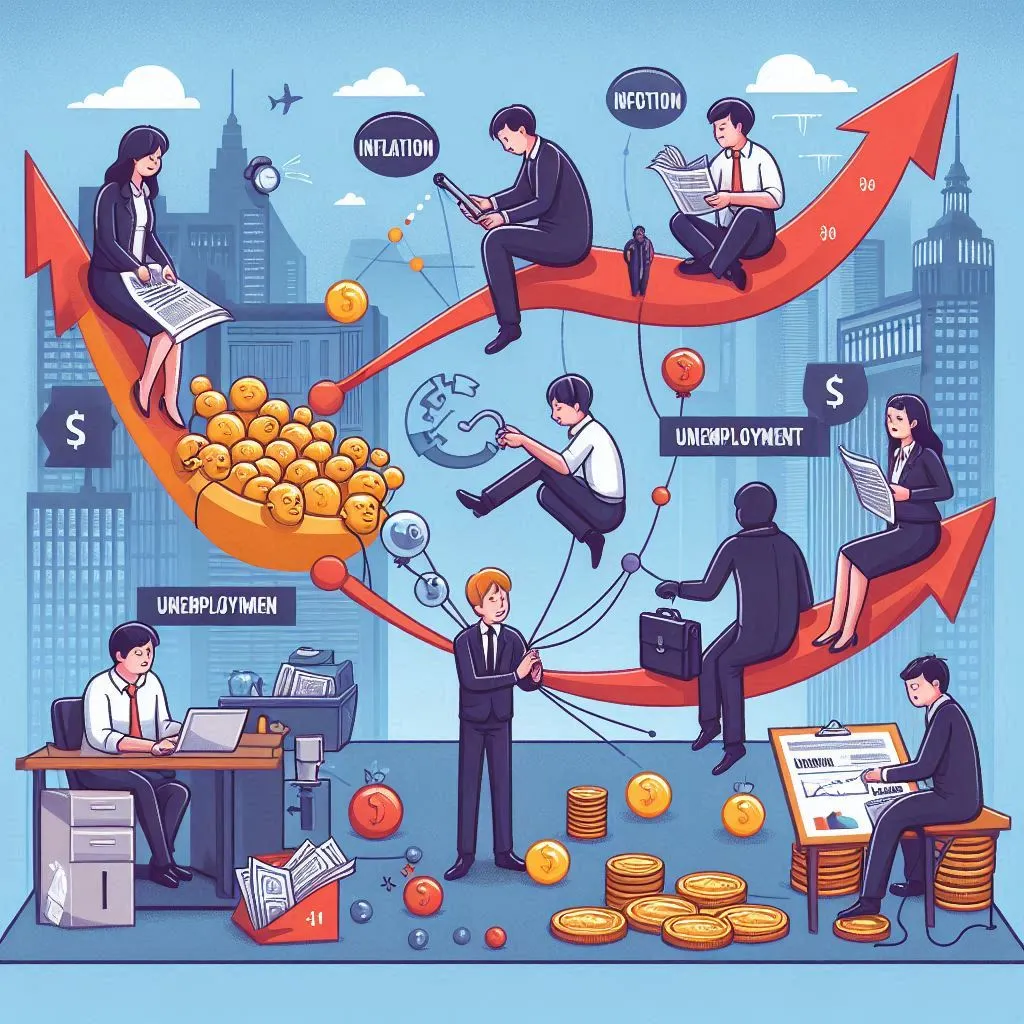- The 1970s: A Turning Point for Macroeconomic Thought
- The 1980s Recession and Potential Policy Shifts
- Historical Analysis of Inflation and Unemployment Cycles
- The Role of Oil Prices in Inflation and Unemployment
- The 1990s: A Unique Economic Phase
- Declining Resource Supplies and Monetary Policy Implications
- The Humphrey-Hawkins Act and Policy Challenges
- The Impact of Job Openings for Economists on Unemployment
- The Implications of Technological Advancements on Unemployment
- Variations in the Natural Unemployment Rate
- The Fed’s Expansionary Policy and the Inflation-Unemployment Cycle
- Conclusion
Inflation and unemployment are two of the most closely watched indicators in macroeconomics. Their relationship has significant implications for economic policy and has been the subject of intense debate among economists, particularly since the tumultuous events of the 1970s. This blog will explore the intricate relationship between inflation and unemployment in modern economies, drawing on historical examples and theoretical frameworks to shed light on how these forces interact and influence each other.
The relationship between inflation and unemployment is a central topic in macroeconomics, reflecting how changes in one can affect the other. In modern economies, this dynamic is influenced by various factors including economic policies, external shocks, and structural changes. The historical context, such as the stagflation of the 1970s and the economic adjustments of the 1980s, provides valuable insights into how inflation and unemployment interact. Understanding these interactions helps policymakers balance objectives of price stability and full employment.
For students working on economics assignments related to inflation, finding reliable resources and support is crucial. Our economics assignment help specialize in providing top- notch inflation assignments, offering expert guidance to help students grasp complex concepts and produce high-quality work. Whether you’re exploring historical trends or current economic issues, our experienced team is here to assist with detailed explanations and tailored support to enhance your academic performance.

The 1970s: A Turning Point for Macroeconomic Thought
The 1970s were a watershed moment in macroeconomic theory, primarily due to the unexpected and simultaneous rise in both inflation and unemployment, a phenomenon known as stagflation. This period challenged the conventional wisdom encapsulated in the Phillips Curve, which suggested an inverse relationship between inflation and unemployment. The increase in unemployment during this time was significant because it disrupted long-held beliefs about how these two variables interact, leading to a reevaluation of economic policies and the introduction of supply-side economics as a response to the limitations of demand-side policies.
The 1980s Recession and Potential Policy Shifts
As the U.S. economy slipped into recession in 1980 and 1981, the Federal Reserve faced immense pressure to adopt an expansionary monetary policy. If the Fed had succumbed to this pressure and initiated such a policy early in 1981, the short-term effects might have included a reduction in unemployment. However, the longer-term consequences, as suggested by the inflation-unemployment cycle, could have been a resurgence of inflation without sustainable employment gains. The Volcker-led Fed chose a different path, focusing on controlling inflation even at the cost of a deep recession. This decision ultimately laid the groundwork for the lower inflation environment of the 1980s and 1990s.
Historical Analysis of Inflation and Unemployment Cycles
To better understand the inflation-unemployment relationship, let’s consider several historical examples:
- Nixon's Economic Satisfaction: During President Nixon's time, when both inflation and unemployment were declining, it suggested that the economy was in a recovery phase. This improvement was likely driven by an increase in aggregate demand, possibly due to fiscal or monetary stimulus.
- Record High Inflation and Rising Unemployment: The early 1970s saw the U.S. economy entering a period of stagflation. Rising unemployment coupled with increasing inflation pointed to a negative supply shock, such as the oil crisis, which simultaneously raised production costs and reduced economic output.
- Carter's Concerns About Inflation: President Carter's era witnessed a late-stage economic expansion, where unemployment was low, but inflationary pressures were increasing. This situation likely resulted from an overheated economy, where aggregate demand outpaced aggregate supply, pushing prices higher.
The Role of Oil Prices in Inflation and Unemployment
Oil price changes have historically played a critical role in the inflation-unemployment cycle, especially during the 1970s. The sharp increases in oil prices acted as supply shocks, leading to higher production costs and contributing to stagflation. Given their significant impact, oil prices should be integrated into the broader theory of the inflation-unemployment cycle to provide a more comprehensive understanding of macroeconomic dynamics.
The 1990s: A Unique Economic Phase
The 1990s represented a unique phase in the U.S. economy, characterized by falling unemployment and declining inflation—a combination that defied the traditional Phillips Curve relationship. This period, often referred to as the "Great Moderation," was marked by technological advancements, globalization, and improved monetary policy. These factors contributed to a more stable economic environment, where inflation remained low despite robust economic growth and low unemployment. The experience of the 1990s suggests that structural changes in the economy can alter the traditional inflation-unemployment relationship.
Declining Resource Supplies and Monetary Policy Implications
Suppose an economy faces declining resource supplies, reducing potential output by 4% annually. In such a scenario, maintaining zero inflation would require a contractionary monetary policy to curb aggregate demand. However, this approach would likely increase unemployment, as the economy would have to operate below its full employment level to avoid inflationary pressures. This example highlights the delicate balance policymakers must strike between managing inflation and maintaining employment.
The Humphrey-Hawkins Act and Policy Challenges
The Humphrey-Hawkins Act of 1978 set ambitious goals for the U.S. economy, aiming to achieve a 4% unemployment rate and keep inflation below 3%. The relationship between inflation and unemployment, particularly the concept of the natural rate of unemployment, suggests that these goals are difficult to achieve simultaneously. Reducing unemployment too far below its natural rate could ignite inflationary pressures, making it challenging to maintain price stability. Achieving these targets requires careful coordination of monetary and fiscal policies, along with structural reforms to enhance productivity and manage inflation expectations.
The Impact of Job Openings for Economists on Unemployment
The American Economic Association's publication, Job Openings for Economists (JOE), likely reduces unemployment among economists by improving the matching process between job seekers and employers. This type of frictional unemployment, which occurs due to the time taken to match workers with jobs, can be mitigated through better information dissemination, as seen with JOE.
The Implications of Technological Advancements on Unemployment
As computer technology becomes increasingly integrated into modern economies, it is expected to lead to a massive restructuring of industries. This technological shift could result in structural unemployment, where workers in obsolete industries or occupations find it challenging to transition to new roles without retraining. The full incorporation of computers into the economy will likely require significant adjustments in the labor market, with potential implications for both unemployment and wage dynamics.
Variations in the Natural Unemployment Rate
The natural unemployment rate in the U.S. has fluctuated over the past 50 years, influenced by factors such as changes in labor market institutions, demographics, and technological advancements. The rise in the natural rate during the 1970s, for instance, might have been driven by the increased participation of women and younger workers, who tend to have higher unemployment rates. Conversely, the decline in the natural rate by 2000 could reflect improvements in job matching technologies, more flexible labor markets, and better monetary policy management.
The Fed’s Expansionary Policy and the Inflation-Unemployment Cycle
If the Federal Reserve implements an expansionary monetary policy to close a recessionary gap, the short-term effect might be a reduction in unemployment. However, as expectations adjust, the economy could experience higher inflation without lasting employment gains. This scenario underscores the importance of managing expectations in monetary policy, as echoed in the maxim, "You can fool some of the people some of the time, but you can’t fool all of the people all of the time."
Conclusion
The relationship between inflation and unemployment is complex and multifaceted, shaped by a variety of factors, including policy decisions, external shocks, and structural changes in the economy. Understanding this relationship is crucial for making informed policy decisions that balance the goals of price stability and full employment. As we continue to navigate modern economic challenges, the lessons from history and the insights from economic theory will remain invaluable in shaping effective responses to the dynamic interplay between inflation and unemployment.
